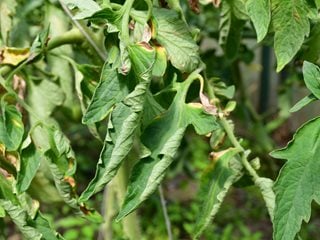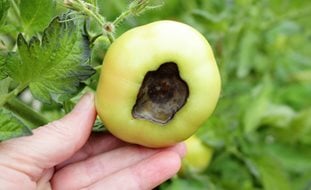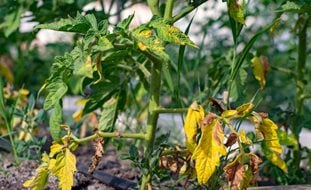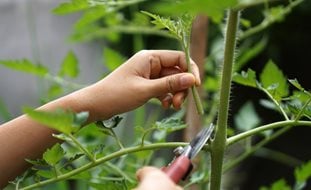Tomato Leaves Curling: Common Causes and What to Do
Find out what causes curling leaves on tomato plants and how to solve the problem Published 9/9/2022Healthy leaves mean a health plan-which means lots of delicious, juicy tomatoes to enjoy. Photo by Proven Winners.
6 REASONS TOMATO LEAVES CURLHealthy tomato plants lead to fresh home-grown fresh summer tomatoes. So, if your tomato leaves are curling, you may be worried that you won't get to enjoy those tasty fruits for long. But there’s good news! Curling tomato leaves doesn’t mean your plants are doomed. Leaf curling can be caused by a variety of factors, all of which can be treated and prevented.
Why Are My Tomato Leaves Curling?
Here are the most common reasons tomato leaves curl and suggested solutions:
1. Extremely High Temperatures:
Even though tomatoes like warm weather and thrive in the heat, consistently hot temperatures that reach 90°F (32°C) and above will cause your tomato leaves to curl. Extreme heat stresses the plant and curling leaves are the plant’s attempt to conserve water and continue fruiting.
To reduce the impact from the heat, use a shade cloth or net. Though it won’t change the ambient heat, it will lessen the intensity and hopefully improve plant growth.
2. Too Much Sun:
Direct sun is typically beneficial for tomato plants, but sometimes the sun can be too intense if UV rays are high. Check the UV index in your area.
When UV rays are exceptionally high, you may notice your tomato plants getting sunburned (turning yellow) and drying up. The plant’s leaves also curl to reduce the amount of surface area exposed to the hot rays.
To lessen damage from the sun, use the same suggestion listed above: use a shade cloth or net. While it won’t completely shield the plant from the sun, it will make the impact less severe.
Tempted to move your tomato to a more hospitable location? See more about transplanting below.
3. Underwatering:
Tomatoes need a lot of water to produce juicy fruits. If there is not enough water in the soil due to high temperatures and/or too much sun, the leaves will curl in an attempt to retain water and survive.
Plants in pots are the most vulnerable to underwatering because they typically dry out faster. Soil in the ground can retain water for longer, but that doesn’t mean tomatoes planted in ground can’t get water deprived.
The obvious solution to underwatering is to water more, but here are some strategies for making the most of your water usage.
- Water at the right time. Watering early in the morning when it’s cooler reduces the amount of water that evaporates before it has the chance to benefit the plant. Even though it’s cooler at night, don’t wait until nighttime to water. This can lead to fungus, rot, and less fruit on your tomato plant.
- Opt for automatic watering. Even gardeners with the best intentions forget to water sometimes. Try to set up automatic watering systems such as drip irrigation or ollas.
- Retain moisture in soil. Top-dress your soil with materials that help absorb and retain water such as natural mulches, hay, and even dried-out grass clippings or twigs.
For more tips, check out the Complete Guide to Watering Tomato Plants.

OlgaSolo / Shutterstock.
4. Poor Soil Nutrition:
To check the nutrition content of your soil, get an at-home soil testing kit that you can use to test the pH, nitrogen, phosphorus, and potassium levels in your soil and determine what it needs.
If your soil is too high in nitrogen, your tomato plant will produce too many leaves and your soil won’t have enough nutrients and water to sustain them. As a result, the leaves will curl and droop downwards.
If your soil does not have enough potassium or phosphorus, it can stunt the growth of your plants, leading to less fruit production, and causing leaves to turn yellow and curl.
Some gardeners have success adding missing nutrients with fertilizer, but make sure you’re using the right type. Learn more about fertilizing.
The best strategy for preventing curled leaves in the future is to amend your soil before planting tomatoes. For soil that’s lacking in nutrients, add compost. You can either use the compost you make at home or purchase organic compost.
5. Viruses:
Unfortunately, there are quite a few viruses that can impact tomato plants, and several of them cause leaf curling and poor growth. Two common ones are yellow leaf curl virus and tomato mosaic virus.
If you do identify a virus on your tomato plants, check nearby for other infected plants. See some of the common problems that ail tomato plants and how to resolve them.
6. Herbicide drift:
Tomatoes are very sensitive to herbicides. This means that if certain weed killers are applied nearby and some drifts onto the leaves of your tomatoes they may sustain herbicide damage. In this case the leaves will often roll downwards.
Avoid using herbicides near your tomatoes, instead try some of these natural ways to get rid of weeds.
Can a mature tomato plant be transplanted?
If your mature tomato plant shows signs of environmental stress from the heat or sun, it may be tempting to try to move it to a different location with a little bit of shade. If you’re growing tomatoes in a container this isn’t too hard, simple move the whole pot. But if they are planted in the ground, proceed with caution.
While it’s technically possible to transplant a tomato plant, it’s not recommended. It’s difficult to pull a mature plant out of the ground without damaging the roots, and the process may shock it.
With that said, if you’ve already tried adding a shade cloth but the heat is just too much and you’re worried about losing the plant, you can attempt to move it as a last resort.
To increase the odds of its survival, give it a thorough watering about 24 hours before you plan to move it. Before transplanting, remove any ripe tomatoes and pinch off the lowest set of leaves.



